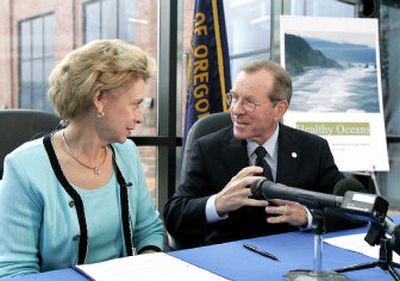West Coast governors take on ocean threat

GRANTS PASS, Ore. – The governors of Oregon, Washington and California announced agreement Monday to seek greater federal support for state efforts to combat threats to the oceans, such as pollution, climate change and declining fisheries.
Noting two national panels had identified the need to act quickly to protect the oceans, the West Coast Governors’ Agreement on Ocean Health, announced at the Oregon Museum of Science and Industry in Portland, said oceans need to be managed on an ecosystem level that crosses political boundaries and demands increased coordination between states and the federal government.
The announcement came as salmon fishermen are coping with sharp cutbacks to protect chinook from Northern California’s Klamath River, scientists are studying a growing zone of oxygen-depleted water killing fish off Oregon and Washington that may be triggered by global warming, and the Bush administration is promoting offshore fish farms that would be beyond state control.
Oregon Gov. Ted Kulongoski said the agreement builds on the three states’ work setting up a “clean-car corridor” to limit tailpipe emissions that contribute to global warming.
“Once again, Oregon, California and Washington are coming together to address the threats facing our ocean,” he said.
Washington Gov. Christine Gregoire said the agreement gives the three states a greater voice opposing offshore oil and gas drilling and promoting federal research.
California Gov. Arnold Schwarzenegger, a Republican, said from Long Beach, Calif., that the agreement with two Democratic governors would give the states more influence in Washington, D.C.
“It is harder for the federal government to ignore us if we speak with one voice,” he said.
In the next six months, the governors said they would jointly call on the White House and Congress to provide enough federal funding to implement existing controls on non-point source pollution, identified as a top threat to coastal waters.
One chief source of that pollution is agricultural runoff, which is responsible for dead zones in Washington’s Hood Canal and the Mississippi Delta in the Gulf of Mexico.
The governors will formally repeat their opposition to offering federal leases to drill for oil and gas off the West Coast, and support development of a regional research plan for the West Coast, including ocean observation programs and mapping the sea floor and ocean habitats.
They will also ask the White House Council on Environmental Quality to help them get more technical help from federal agencies to address threats to the ocean.
Long-term goals include ensuring clean coastal waters and beaches, restoring healthy coastal habitats, reducing harm from offshore development, expanding ocean research, and promoting sustainable economic development in coastal communities.
After the Pew Oceans Commission and the U.S. Commission on Ocean Policy identified dire threats to the oceans in 2003 and 2004, respectively, the federal government has been slow to take action, said Mark Abbott, dean of the College of Oceanic and Atmospheric Sciences at Oregon State University and co-chairman of the Governor’s Climate Change Advisory Group.
“We are demanding more of our oceans and we are seeing many more complex problems emerge,” Abbott said. “We haven’t seen the level of federal commitment we need.”
Leon Panetta, chairman of the Pew Oceans Commission and former chief of staff to President Clinton, said from Los Angeles that states are far ahead of the federal government in addressing ocean threats. “Our oceans are in crisis,” Panetta said. “Unfortunately there isn’t a lot of strong leadership on this issue coming out of Washington, either from the president or from Congress. In that vacuum, we’re seeing a lot of leadership being shown at the regional and state level.”